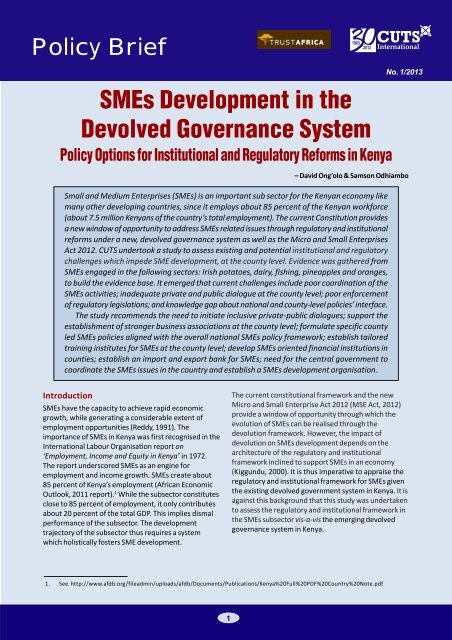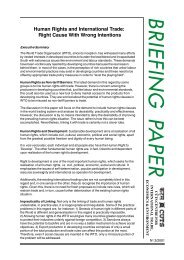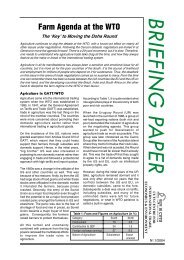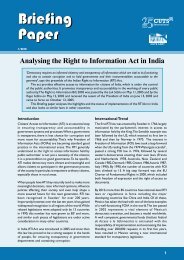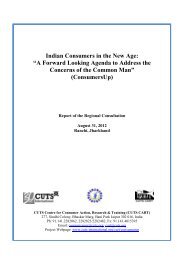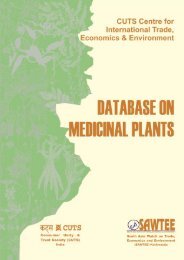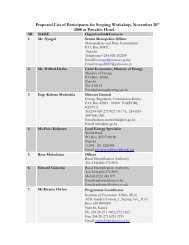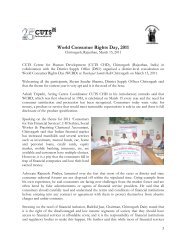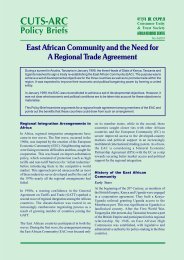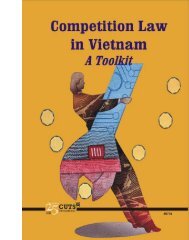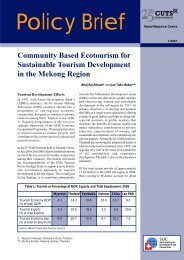SMEs Development in the Devolved Governance System
SMEs Development in the Devolved Governance System
SMEs Development in the Devolved Governance System
- No tags were found...
Create successful ePaper yourself
Turn your PDF publications into a flip-book with our unique Google optimized e-Paper software.
Policy Brief<strong>SMEs</strong> <strong>Development</strong> <strong>in</strong> <strong>the</strong><strong>Devolved</strong> <strong>Governance</strong> <strong>System</strong>Policy Options for Institutional and Regulatory Reforms <strong>in</strong> KenyaNo. 1/2013– David Ong’olo & Samson OdhiamboSmall and Medium Enterprises (<strong>SMEs</strong>) is an important sub sector for <strong>the</strong> Kenyan economy likemany o<strong>the</strong>r develop<strong>in</strong>g countries, s<strong>in</strong>ce it employs about 85 percent of <strong>the</strong> Kenyan workforce(about 7.5 million Kenyans of <strong>the</strong> country’s total employment). The current Constitution providesa new w<strong>in</strong>dow of opportunity to address <strong>SMEs</strong> related issues through regulatory and <strong>in</strong>stitutionalreforms under a new, devolved governance system as well as <strong>the</strong> Micro and Small EnterprisesAct 2012. CUTS undertook a study to assess exist<strong>in</strong>g and potential <strong>in</strong>stitutional and regulatorychallenges which impede SME development, at <strong>the</strong> county level. Evidence was ga<strong>the</strong>red from<strong>SMEs</strong> engaged <strong>in</strong> <strong>the</strong> follow<strong>in</strong>g sectors: Irish potatoes, dairy, fish<strong>in</strong>g, p<strong>in</strong>eapples and oranges,to build <strong>the</strong> evidence base. It emerged that current challenges <strong>in</strong>clude poor coord<strong>in</strong>ation of <strong>the</strong><strong>SMEs</strong> activities; <strong>in</strong>adequate private and public dialogue at <strong>the</strong> county level; poor enforcementof regulatory legislations; and knowledge gap about national and county-level policies’ <strong>in</strong>terface.The study recommends <strong>the</strong> need to <strong>in</strong>itiate <strong>in</strong>clusive private-public dialogues; support <strong>the</strong>establishment of stronger bus<strong>in</strong>ess associations at <strong>the</strong> county level; formulate specific countyled <strong>SMEs</strong> policies aligned with <strong>the</strong> overall national <strong>SMEs</strong> policy framework; establish tailoredtra<strong>in</strong><strong>in</strong>g <strong>in</strong>stitutes for <strong>SMEs</strong> at <strong>the</strong> county level; develop <strong>SMEs</strong> oriented f<strong>in</strong>ancial <strong>in</strong>stitutions <strong>in</strong>counties; establish an import and export bank for <strong>SMEs</strong>; need for <strong>the</strong> central government tocoord<strong>in</strong>ate <strong>the</strong> <strong>SMEs</strong> issues <strong>in</strong> <strong>the</strong> country and establish a <strong>SMEs</strong> development organisation.Introduction<strong>SMEs</strong> have <strong>the</strong> capacity to achieve rapid economicgrowth, while generat<strong>in</strong>g a considerable extent ofemployment opportunities (Reddy, 1991). Theimportance of <strong>SMEs</strong> <strong>in</strong> Kenya was first recognised <strong>in</strong> <strong>the</strong>International Labour Organisation report on‘Employment, Income and Equity <strong>in</strong> Kenya’ <strong>in</strong> 1972.The report underscored <strong>SMEs</strong> as an eng<strong>in</strong>e foremployment and <strong>in</strong>come growth. <strong>SMEs</strong> create about85 percent of Kenya’s employment (African EconomicOutlook, 2011 report). 1 While <strong>the</strong> subsector constitutesclose to 85 percent of employment, it only contributesabout 20 percent of <strong>the</strong> total GDP. This implies dismalperformance of <strong>the</strong> subsector. The developmenttrajectory of <strong>the</strong> subsector thus requires a systemwhich holistically fosters SME development.The current constitutional framework and <strong>the</strong> newMicro and Small Enterprise Act 2012 (MSE Act, 2012)provide a w<strong>in</strong>dow of opportunity through which <strong>the</strong>evolution of <strong>SMEs</strong> can be realised through <strong>the</strong>devolution framework. However, <strong>the</strong> impact ofdevolution on <strong>SMEs</strong> development depends on <strong>the</strong>architecture of <strong>the</strong> regulatory and <strong>in</strong>stitutionalframework <strong>in</strong>cl<strong>in</strong>ed to support <strong>SMEs</strong> <strong>in</strong> an economy(Kiggundu, 2000). It is thus imperative to appraise <strong>the</strong>regulatory and <strong>in</strong>stitutional framework for <strong>SMEs</strong> given<strong>the</strong> exist<strong>in</strong>g devolved government system <strong>in</strong> Kenya. It isaga<strong>in</strong>st this background that this study was undertakento assess <strong>the</strong> regulatory and <strong>in</strong>stitutional framework <strong>in</strong><strong>the</strong> <strong>SMEs</strong> subsector vis-a-vis <strong>the</strong> emerg<strong>in</strong>g devolvedgovernance system <strong>in</strong> Kenya.1. See http://www.afdb.org/fileadm<strong>in</strong>/uploads/afdb/Documents/Publications/Kenya%20Full%20PDF%20Country%20Note.pdf1
MethodologyThe study was conducted <strong>in</strong> Homabay, Kwale, Kiambuand Bomet counties. Case studies of Irish potatoes,dairy, fish<strong>in</strong>g, p<strong>in</strong>eapples and oranges were used tounderstand <strong>the</strong> various <strong>in</strong>stitutional and regulatorychallenges fac<strong>in</strong>g <strong>the</strong> <strong>SMEs</strong> <strong>in</strong> Kenya.Table 1: Subsectors and CountiesCountySubsectorKiambu and Bomet Dairy and Irish potatoesHomabayFish<strong>in</strong>g and p<strong>in</strong>eappleKwaleOranges and fish<strong>in</strong>gThe research team exam<strong>in</strong>ed relevant secondarydocumentation which <strong>in</strong>cluded reports, various policydocuments and <strong>in</strong>ternet sources. The review also<strong>in</strong>cluded a comparative case analysis of more advancedeconomies <strong>in</strong> <strong>SMEs</strong> development like India and Republicof South Africa (RSA). The study adopted <strong>the</strong>Participatory Competitive Advantage (PACA)methodology to collect <strong>the</strong> primary data. Focus groupdiscussions were conducted <strong>in</strong> Homabay, Kwale, Bometand Kiambu counties. In-depth <strong>in</strong>terviews were heldwith key <strong>in</strong>formants through questionnaires. Commonpolicy positions were deduced from <strong>the</strong> fieldworkf<strong>in</strong>d<strong>in</strong>gs and literature review analysis.F<strong>in</strong>d<strong>in</strong>gsProduction ChallengesComparative analysis across <strong>the</strong> five subsectorsconfirmed common production challenges like<strong>in</strong>adequate <strong>in</strong>puts and lack of production technologyfor better crop and livestock production. Productionchallenges were attributed to limited access to f<strong>in</strong>ancefor <strong>SMEs</strong>, despite <strong>the</strong> existence of various f<strong>in</strong>ancial<strong>in</strong>stitutions. This was primarily due to str<strong>in</strong>gentconditions set by <strong>the</strong> f<strong>in</strong>ancial <strong>in</strong>stitutions. For <strong>in</strong>stance,<strong>the</strong> Kenya Industrial Estates requires that <strong>the</strong> <strong>SMEs</strong>should be <strong>in</strong> a registered association or group, to beable to access loans. However, most of <strong>the</strong> <strong>SMEs</strong> do notqualify to access <strong>the</strong> loans as <strong>the</strong>y do not belong to anyof <strong>the</strong> producer associations.Comparative analysis <strong>in</strong> <strong>the</strong> case of India and RSA iscontrary to <strong>the</strong> situation <strong>in</strong> Kenya. For <strong>in</strong>stance, <strong>the</strong>reis <strong>the</strong> South Africa Micro F<strong>in</strong>ance Fund and <strong>the</strong> SmallIndustries <strong>Development</strong> Bank - <strong>in</strong> South Africa andIndia, respectively. The Indian government has alsoestablished <strong>the</strong> Export-Import Bank to assist <strong>the</strong> SMEunits <strong>in</strong> plac<strong>in</strong>g <strong>the</strong>ir products <strong>in</strong> <strong>the</strong> <strong>in</strong>ternationalmarkets.2
Market<strong>in</strong>g & Value Addition ChallengesThe implication of limited access to f<strong>in</strong>ance was alsoaffirmed by various participants to have variousimplications on market<strong>in</strong>g and value addition. High costof acquir<strong>in</strong>g cool<strong>in</strong>g plants; process<strong>in</strong>g <strong>in</strong>frastructureand storage facilities were cited by farmers. O<strong>the</strong>rchallenges <strong>in</strong>clude limited tra<strong>in</strong><strong>in</strong>gs facilities on farmproduction, <strong>in</strong>adequate entrepreneur skills and limitedtechnical knowhow on process<strong>in</strong>g.It was also felt that most <strong>SMEs</strong> players do not have<strong>the</strong> relevant skills to facilitate value addition activities,thus promot<strong>in</strong>g exploitation by middlemen. It was alsoestablished that <strong>the</strong> Kenya Industrial Research and<strong>Development</strong> Institute (KIRDI) impacts on valueaddition are yet to be realised <strong>in</strong> most of <strong>the</strong> counties <strong>in</strong>Kenya as farmers still market unprocessed produce atrelatively low prices.Regulatory & Institutional Challenges(a) Poor coord<strong>in</strong>ation of <strong>SMEs</strong> activities: Closeranalysis of <strong>the</strong> key study f<strong>in</strong>d<strong>in</strong>gs and literaturereview confirms existence of multiple<strong>in</strong>stitutions and departments handl<strong>in</strong>g <strong>SMEs</strong>issues <strong>in</strong> Kenya. For <strong>in</strong>stance, <strong>the</strong> M<strong>in</strong>istry ofTrade, <strong>the</strong> M<strong>in</strong>istry of Industrialisation and <strong>the</strong>M<strong>in</strong>istry of Labour have departments related to<strong>SMEs</strong>. There is lack of coord<strong>in</strong>ated strategiesand approaches to stimulate <strong>SMEs</strong>development <strong>in</strong> Kenya. However, <strong>the</strong> scenariois contrary <strong>in</strong> <strong>the</strong> case of India and RSA. For<strong>in</strong>stance, <strong>the</strong> M<strong>in</strong>istry of Micro, Small andMedium Enterprises <strong>in</strong> India and <strong>the</strong>Department of Internal Trade and Industry <strong>in</strong>South Africa are designated l<strong>in</strong>e m<strong>in</strong>istriesresponsible for <strong>the</strong> overall coord<strong>in</strong>ation of <strong>the</strong><strong>SMEs</strong> related activities <strong>in</strong> <strong>the</strong>se countries.(b) Inadequate private and public dialogue at <strong>the</strong>local (County) Level: Even though <strong>the</strong> privatepublicdialogue has been emphasised at <strong>the</strong>central level, through <strong>the</strong> Kenya Private SectorAlliance (KEPSA), most stakeholders citedlimited consultation at <strong>the</strong> ground-level dur<strong>in</strong>gpolicy mak<strong>in</strong>g processes. Such limitedconsultation was attributed to lack of strongsector-specific associations of <strong>SMEs</strong> at <strong>the</strong> locallevel. Some of <strong>the</strong> exist<strong>in</strong>g associations areweak and lack fund<strong>in</strong>g to participate <strong>in</strong>relevant policy related discussions. On <strong>the</strong>o<strong>the</strong>r hand, a comparative case analysis fromIndia and RSA affirms a formal <strong>in</strong>stitutionalstructure for <strong>SMEs</strong> development. The exist<strong>in</strong>gregulatory structure depicts <strong>in</strong>stitutionalisedsystem for private and public dialogue for <strong>SMEs</strong>consultation, framework for stronger <strong>SMEs</strong>association and stronger <strong>in</strong>stitutional l<strong>in</strong>kagesand coord<strong>in</strong>ation.3
(c) Poor enforcement of regulatory legislations:The f<strong>in</strong>d<strong>in</strong>gs affirm limited coord<strong>in</strong>ation <strong>in</strong><strong>the</strong> implementation of <strong>the</strong> <strong>SMEs</strong>-relatedprogrammes and policies <strong>in</strong> Kenya. For<strong>in</strong>stance, <strong>the</strong> implementation of <strong>the</strong> LegalNotice No.44 <strong>in</strong> <strong>the</strong> potato <strong>in</strong>dustry hasbeen <strong>in</strong>adequate due to limitedcoord<strong>in</strong>ation between <strong>the</strong> M<strong>in</strong>istry ofAgriculture and <strong>the</strong> Local Authorities <strong>in</strong> <strong>the</strong>counties. The same scenario is also evident<strong>in</strong> <strong>the</strong> fish<strong>in</strong>g <strong>in</strong>dustry where <strong>the</strong>implementation of <strong>the</strong> regulation on <strong>the</strong>beach management units has not beenrealised as per <strong>the</strong> <strong>in</strong>tended objectives.There are also <strong>in</strong>stitutional challenges <strong>in</strong>regulation of <strong>the</strong> dairy <strong>in</strong>dustry, where <strong>the</strong>regulator (Kenya Dairy Board) does not have<strong>in</strong>tensive presence at <strong>the</strong> county level.(d) Knowledge gap on National and Countypolicies’ <strong>in</strong>terface: The extent to which <strong>the</strong>new county system contributes to <strong>SMEs</strong>development depends on how best <strong>the</strong>operationalisation of <strong>the</strong> current MSE Act,2012 factors <strong>in</strong> <strong>the</strong> necessary adm<strong>in</strong>istrativechanges as outl<strong>in</strong>ed <strong>in</strong> <strong>the</strong> currentConstitution of Kenya.Implications and PolicyRecommendationsThe research f<strong>in</strong>d<strong>in</strong>gs from <strong>the</strong> field affirm commonchallenges fac<strong>in</strong>g <strong>the</strong> <strong>SMEs</strong> <strong>in</strong> <strong>the</strong> counties and atsub-sector level. The challenges are related toproduction, market<strong>in</strong>g, <strong>in</strong>stitutional and regulatoryissues. Most of <strong>the</strong>se challenges are county-specific<strong>in</strong> nature. However, <strong>the</strong> challenges are alsocommon especially <strong>in</strong> those counties that aredom<strong>in</strong>ated by agricultural activities.The challenges require a strategy that wouldpromote easy access to credit and farm <strong>in</strong>puts,promote value addition activities and establish awell-coord<strong>in</strong>ated and effective <strong>in</strong>stitutional andregulatory framework. There is also a gap <strong>in</strong> termsof <strong>in</strong>formation available regard<strong>in</strong>g <strong>the</strong>operationalisation of certa<strong>in</strong> <strong>in</strong>stitutions/agenciesat <strong>the</strong> country level.O<strong>the</strong>r key policy issues aris<strong>in</strong>g from <strong>the</strong> researchf<strong>in</strong>d<strong>in</strong>gs are pegged on <strong>the</strong> fact that <strong>the</strong>re is lack ofa formal <strong>in</strong>stitutional framework both at <strong>the</strong>national and local level, dedicated to <strong>SMEs</strong>development. The <strong>in</strong>stitutional deficiency hascontributed to unclear consultation mechanism at<strong>the</strong> local level between <strong>the</strong> private sector and <strong>the</strong>government.4
Policy RecommendationsThe new Constitutional dispensation and <strong>the</strong><strong>in</strong>stitutional framework proposed under <strong>the</strong> new<strong>SMEs</strong> Act are important developments that canlead to fur<strong>the</strong>r evolution and success of <strong>SMEs</strong> <strong>in</strong>Kenya, if properly implemented. Some of <strong>the</strong>f<strong>in</strong>d<strong>in</strong>gs and related recommendations of thisreport will help <strong>in</strong> such actions.In <strong>the</strong> context of Kenya, SME developmentrequires a cross-cutt<strong>in</strong>g strategy that touchesupon many areas, which can help <strong>the</strong> sector toimprove and create a niche for itself <strong>in</strong> <strong>the</strong>Kenyan economy. A set of measures <strong>in</strong> thisregard has been suggested below:Establish an <strong>in</strong>clusive Private-Publicdialogue: A formal and organised <strong>SMEs</strong>structure would provide direction on how<strong>the</strong> county government should establish aformal coord<strong>in</strong>ation structure. Thesecould <strong>in</strong>clude national consultative panels;regional and local panels; explicit andopen policy development processes; andtransparent government activities.Support establishment of strong <strong>SMEs</strong>associations (county level): The overalland county specific government policiesfor <strong>SMEs</strong> should emphasise on build<strong>in</strong>galliances <strong>in</strong> <strong>the</strong> various <strong>SMEs</strong> sub sectors.The government should provide support toenhance legitimate representative organisationsat <strong>the</strong> county level. Such networks/associationswould assist <strong>in</strong> lobby<strong>in</strong>g and policy advocacythrough <strong>the</strong> county assembly and citizens’ fora.Associations of <strong>SMEs</strong> engaged <strong>in</strong> <strong>the</strong> sameproduct should be promoted, especially atcountry levels.Formulate specific county led <strong>SMEs</strong> policiesand programmes: There is need for each countyto evolve its own policies and packages of<strong>in</strong>centives based on <strong>the</strong> county’s economiccompetitiveness. Such policies should be<strong>in</strong>formed by diagnostic studies undertaken toidentify <strong>the</strong> ‘competitive advantage’ of aparticular county <strong>in</strong> <strong>the</strong> <strong>SMEs</strong> sector. However,for <strong>the</strong> sake of stronger coord<strong>in</strong>ation, <strong>the</strong> centralgovernment should rema<strong>in</strong> to be <strong>the</strong> overalloverseer of all <strong>the</strong> <strong>SMEs</strong> strategies <strong>in</strong> eachcounty to assist <strong>in</strong> <strong>the</strong> promotion of <strong>the</strong> <strong>SMEs</strong>activities.Establish tailored tra<strong>in</strong><strong>in</strong>g Institutes for <strong>SMEs</strong>(<strong>in</strong> Counties): Even though <strong>the</strong>re aregovernment <strong>in</strong>stitutions provid<strong>in</strong>g courses on<strong>SMEs</strong> issues, it would be important for <strong>the</strong>government to establish <strong>SMEs</strong> specific tra<strong>in</strong><strong>in</strong>g<strong>in</strong>stitutes especially <strong>in</strong> each county based on <strong>the</strong>county’s competitiveness and its productionoutput.5
Establish <strong>SMEs</strong> oriented f<strong>in</strong>ancial <strong>in</strong>stitutions(County level): There is need for specific <strong>SMEs</strong>oriented banks to facilitate <strong>the</strong> promotion,f<strong>in</strong>anc<strong>in</strong>g and development of <strong>the</strong> small scale<strong>in</strong>dustries. The f<strong>in</strong>ancial <strong>in</strong>stitution should offer awide range of f<strong>in</strong>ancial products ei<strong>the</strong>r directlyor <strong>in</strong>directly. The f<strong>in</strong>ancial <strong>in</strong>stitution for <strong>SMEs</strong>should be established <strong>in</strong> each county to enhanceeasy access for potential and exist<strong>in</strong>g <strong>SMEs</strong>.Establish an Import-Export Bank for <strong>SMEs</strong>:The government should also considerestablish<strong>in</strong>g an import and export bank for<strong>SMEs</strong>. The bank should focus on SME exportersas its target beneficiaries. The bank shouldproactively assist <strong>the</strong> SME units <strong>in</strong> establish<strong>in</strong>g<strong>the</strong>ir products <strong>in</strong> <strong>in</strong>ternational markets anddevelop<strong>in</strong>g <strong>the</strong> markets with<strong>in</strong> <strong>the</strong> value cha<strong>in</strong>.Central coord<strong>in</strong>at<strong>in</strong>g <strong>in</strong>stitution: The proposedMicro and Small Enterprises Authority under <strong>the</strong>MSE Act, 2012 should focus on policyarticulation, promotion, development andprotection of <strong>SMEs</strong>. It should also monitor <strong>the</strong>execution of <strong>the</strong> formulated policies and <strong>the</strong>effectiveness <strong>in</strong> <strong>the</strong>ir implementation. It mustwork directly with <strong>the</strong> relevant departments at<strong>the</strong> county government and should facilitate <strong>the</strong>establishment of a <strong>SMEs</strong> One-Stop-Centre whereall <strong>the</strong> national issues regard<strong>in</strong>g <strong>SMEs</strong> areaddressed.Establish<strong>in</strong>g a s<strong>in</strong>gle w<strong>in</strong>dow for <strong>SMEs</strong>: Thegovernment should develop requirements andcriteria for <strong>SMEs</strong> operations where strictregulations for <strong>SMEs</strong> entry and exit should beestablished to ensure that only <strong>the</strong> skill-based<strong>SMEs</strong> are permitted to operate <strong>in</strong> <strong>the</strong> market.Cross county knowledge shar<strong>in</strong>g andexchanges: The f<strong>in</strong>d<strong>in</strong>gs confirm diversity <strong>in</strong>terms of resources, experiences and sub sectorperformance across different counties. There isneed to promote cross county collaboration byshar<strong>in</strong>g experiences and skills through field visitsto understand cross county experiences.ConclusionThis study has shown that <strong>the</strong>re are differences <strong>in</strong>county specific and sectoral needs of <strong>SMEs</strong> <strong>in</strong>Kenya. These supportive needs across <strong>the</strong> differentvalue cha<strong>in</strong>s should be provided. Even though <strong>the</strong>new <strong>in</strong>stitutional structure of <strong>the</strong> countygovernment after <strong>the</strong> recent elections is now areality, it is generally agreed that its fulloperationalisation will take some time.Meanwhile, <strong>the</strong>re will be need for <strong>the</strong> TransitionalAuthority to work closely with <strong>the</strong> newlyestablished Small and MediumEnterprise <strong>Development</strong> Authority, Kenya toidentify county and value cha<strong>in</strong> specific needs for<strong>SMEs</strong>. It is only by recognis<strong>in</strong>g this that <strong>the</strong> <strong>SMEs</strong>will be able to efficiently provide a source ofemployment and <strong>in</strong>come for millions of Kenyans.ReferencesILO (1972). “Employment, <strong>in</strong>comes and equity: a strategy of <strong>in</strong>creas<strong>in</strong>g productive employment <strong>in</strong> Kenya”. Geneva:International Labour OrganisationReddy, R.J.P. 1991. Problems and <strong>Development</strong> of Small Scale Industries In India, New Delhi: Discovery Publish<strong>in</strong>gHouse.(Courtesy: Pictures are taken from <strong>the</strong> <strong>in</strong>ternet)This Policy Brief has been prepared by David Ong’olo & Samson Odhiambo of and for CUTS, Nairobi under <strong>the</strong> project entitled,‘Assessment of <strong>the</strong> Regulatory and Institutional Challenges Affect<strong>in</strong>g <strong>SMEs</strong> <strong>Development</strong> <strong>in</strong> Kenya’ implemented by CUTSNairobi with <strong>the</strong> support of Trust Africa (through <strong>the</strong> Investment Climate and Bus<strong>in</strong>ess Environment Research Fund). The views/op<strong>in</strong>ions expressed here<strong>in</strong> are those of <strong>the</strong> author and do not necessarily reflect <strong>the</strong> views of Trust Africa.CUTS Policy Briefs are meant to <strong>in</strong>form and educate readers and provoke debate on specific issues. Readers are encouraged toquote or reproduce material from this paper for <strong>the</strong>ir own use, but as a copyright holder, CUTS request due acknowledgement anda copy of <strong>the</strong> publication.© CUTS Nairobi 2013. CUTS Nairobi, Yaya Court, Second Floor, Room No. 5, R<strong>in</strong>g Road, Kilimani, Nairobi, Kenya.Ph: +254-20-3862149. Fax: +254-20-3862149, E-mail: nairobi@cuts.org, Web: www.cuts-<strong>in</strong>ternational.org/ARC/Nairobi6


